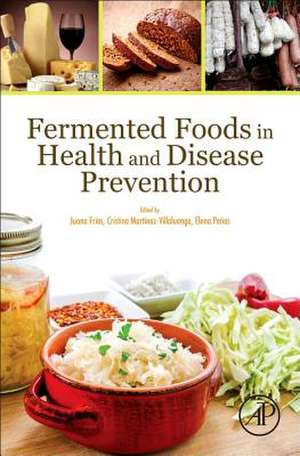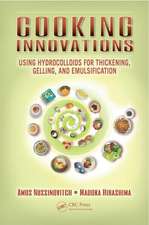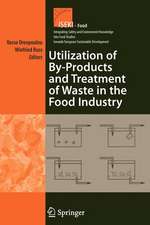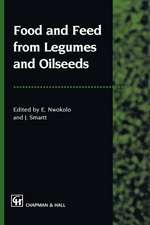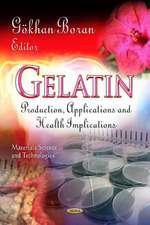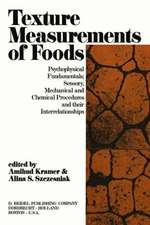Fermented Foods in Health and Disease Prevention
Editat de Juana Frías, Cristina Martinez-Villaluenga, Elena Peñasen Limba Engleză Hardback – 23 sep 2016
Coverage in the book includes the role of microorganisms that are involved in the fermentation of bioactive and potentially toxic compounds, their contribution to health-promoting properties, and the safety of traditional fermented foods. Authored by worldwide scientists and researchers, this book provides the food industry with new insights on the development of value-added fermented foods products, while also presenting nutritionists and dieticians with a useful resource to help them develop strategies to assist in the prevention of disease or to slow its onset and severity.
- Provides a comprehensive review on current findings in the functional properties and safety of traditional fermented foods and their impact on health and disease prevention
- Identifies bioactive microorganisms and components in traditional fermented food
- Includes focused key facts, helpful glossaries, and summary points for each chapter
- Presents food processors and product developers with opportunities for the development of fermented food products
- Helps readers develop strategies that will assist in preventing or slowing disease onset and severity
Preț: 857.77 lei
Preț vechi: 1111.22 lei
-23% Nou
Puncte Express: 1287
Preț estimativ în valută:
164.13€ • 171.83$ • 135.81£
164.13€ • 171.83$ • 135.81£
Carte tipărită la comandă
Livrare economică 29 martie-12 aprilie
Preluare comenzi: 021 569.72.76
Specificații
ISBN-13: 9780128023099
ISBN-10: 0128023090
Pagini: 762
Dimensiuni: 152 x 229 x 76 mm
Greutate: 1.32 kg
Editura: ELSEVIER SCIENCE
ISBN-10: 0128023090
Pagini: 762
Dimensiuni: 152 x 229 x 76 mm
Greutate: 1.32 kg
Editura: ELSEVIER SCIENCE
Public țintă
food scientists, technologists, food processors, product developers, food industry workers, research scientists, nutrition researchers, health professionalsCuprins
Section 1. Introduction
1. Fermented Foods in Health Promotion and Disease Prevention: An Overview
Section 2. Fermented Foods as a Source of Healthy Constituents
2. Bioactive Peptides in Fermented Foods: Production and Evidence for Health Effects
3. Health Benefits of Exopolysaccharides in Fermented Foods
4. Biotransformation of Phenolics by Lactobacillus plantarum in Fermented Foods
5. Gamma-Aminobutyric Acid-Enriched Fermented Foods
6. Melatonin Synthesis in Fermented Foods
7. Effect of Fermentation on Vitamin Content in Food
8. From Bacterial Genomics to Human Health
Section 3. Traditional Fermented Foods
Section 3.1. Fermented Food of Animal Origin
9. Fermented Seafood Products and Health
10. Fermented Meat Sausage
Section 3.2. Dairy Fermented Foods
11. Health Effects of Cheese Components with a Focus on Bioactive Peptides
12. Blue Cheese: Microbiota and Fungal Metabolites
13. Yogurt and Health
14. Kefir
Section 3.3. Legume and Cereal Grains Fermented Derived Products
15. Beer and Its Role in Human Health
16. Fermented Pulses in Nutrition and Health Promotion
17. Nonwheat Cereal-Fermented-Derived Products
18. Use of Sourdough Fermentation and Nonwheat Flours for Enhancing Nutritional and Healthy Properties of Wheat-Based Foods
19. Tempeh and Other Fermented Soybean Products Rich in Isoflavones
Section 3.4. Vegetables and Fruits Fermented Products
20. Kimchi and Its Health Benefits
21. The Naturally Fermented Sour Pickled Cucumbers
22. Role of Natural Fermented Olives in Health and Disease
23. Pulque
24. Sauerkraut: Production, Composition, and Health Benefits
25. Vinegars and Other Fermented Condiments
26. Wine
Section 4. Hazardous Compounds and Their Implications in Fermented Foods
27. Biogenic Amines in Fermented Foods and Health Implications
28. Occurrence of Aflatoxins in Fermented Food Products
29. Antibiotic Resistance Profile of Microbes From Traditional Fermented Foods
Section 5. Revalorization of Food Wastes by Fermentation into Derived Outcomes
30. Fermentation of Food Wastes for Generation of Nutraceuticals and Supplements
1. Fermented Foods in Health Promotion and Disease Prevention: An Overview
Section 2. Fermented Foods as a Source of Healthy Constituents
2. Bioactive Peptides in Fermented Foods: Production and Evidence for Health Effects
3. Health Benefits of Exopolysaccharides in Fermented Foods
4. Biotransformation of Phenolics by Lactobacillus plantarum in Fermented Foods
5. Gamma-Aminobutyric Acid-Enriched Fermented Foods
6. Melatonin Synthesis in Fermented Foods
7. Effect of Fermentation on Vitamin Content in Food
8. From Bacterial Genomics to Human Health
Section 3. Traditional Fermented Foods
Section 3.1. Fermented Food of Animal Origin
9. Fermented Seafood Products and Health
10. Fermented Meat Sausage
Section 3.2. Dairy Fermented Foods
11. Health Effects of Cheese Components with a Focus on Bioactive Peptides
12. Blue Cheese: Microbiota and Fungal Metabolites
13. Yogurt and Health
14. Kefir
Section 3.3. Legume and Cereal Grains Fermented Derived Products
15. Beer and Its Role in Human Health
16. Fermented Pulses in Nutrition and Health Promotion
17. Nonwheat Cereal-Fermented-Derived Products
18. Use of Sourdough Fermentation and Nonwheat Flours for Enhancing Nutritional and Healthy Properties of Wheat-Based Foods
19. Tempeh and Other Fermented Soybean Products Rich in Isoflavones
Section 3.4. Vegetables and Fruits Fermented Products
20. Kimchi and Its Health Benefits
21. The Naturally Fermented Sour Pickled Cucumbers
22. Role of Natural Fermented Olives in Health and Disease
23. Pulque
24. Sauerkraut: Production, Composition, and Health Benefits
25. Vinegars and Other Fermented Condiments
26. Wine
Section 4. Hazardous Compounds and Their Implications in Fermented Foods
27. Biogenic Amines in Fermented Foods and Health Implications
28. Occurrence of Aflatoxins in Fermented Food Products
29. Antibiotic Resistance Profile of Microbes From Traditional Fermented Foods
Section 5. Revalorization of Food Wastes by Fermentation into Derived Outcomes
30. Fermentation of Food Wastes for Generation of Nutraceuticals and Supplements
